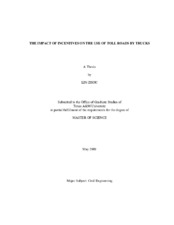| dc.description.abstract | States are increasingly using toll roads as a means of financing transportation capital
needs as well as expanding transportation system capacity. Whether toll roads can attract
trucks partially determines the performance of the investment. Unfortunately, the low
profit margin in the trucking industry and the relatively high tolls truckers pay leads to
their reluctance to use toll facilities. Incentives for truck use of a toll road, State Highway
130 (SH 130) near Austin, Texas, were analyzed in this research. As a parallel toll road
to the non-tolled, congested facility Interstate 35 (I-35), SH 130 was projected to carry a
lot of traffic, including a significant proportion of trucks. In order to make this tolled
facility more attractive to trucks, innovative incentives were considered. The potential
truck demand for SH 130 and their potential reactions to the incentives were estimated in
this research based on survey data.
According to survey responses, different groups of the trucking industry had very
different characteristics. Due to the variation of the characteristics among different
categories of trucks, truckers’ travel behavior and incentive preference were also different by trucking group. Compared with other groups of truckers, smaller companies
(owner-operators) were the least likely to use SH 130, while private carriers were the
most likely to use SH 130. It was also found many truckers had already made
adjustments both to their time and route to avoid traveling in congested conditions.
Among all the categories of truckers, for-hire truckers had the least flexibility.
The average value of travel time savings of trucks around the Austin area was $44.20 per
hour. As the price of travel time savings went up, the percentage of truckers using SH
130 decreased. Price-related incentives were discovered to be most popular with truckers.
Among all of the price-related incentives, off-peak discounts and a free trip after a
number of paid trips were the most popular incentives. | en |


